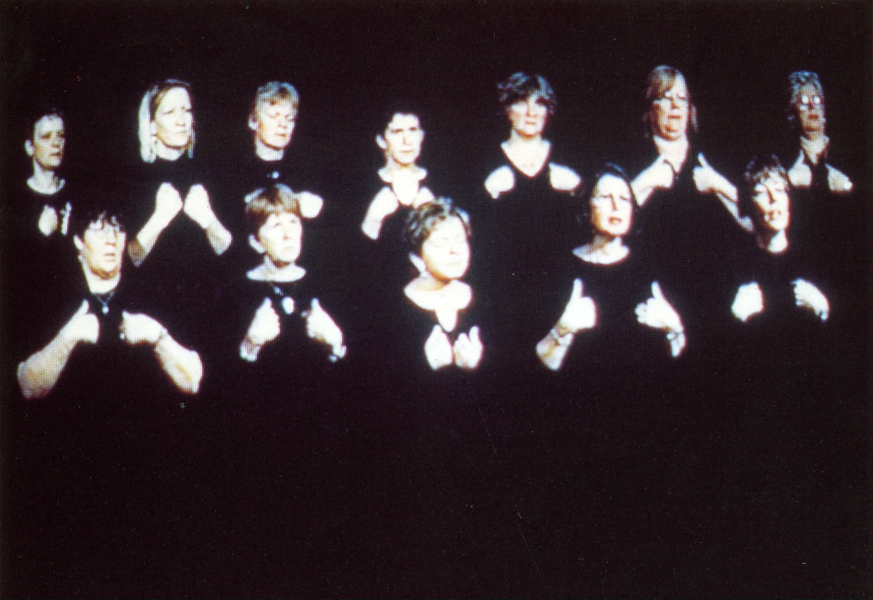
God Save The Queen, I Want To Be Free, 2002
Beth Dervishire
God Save The Queen, I Want To Be Free, 2002
Double Video Projection
search


Beth Dervishire
God Save The Queen, I Want To Be Free, 2002
Double Video Projection
Two anthems are performed by the deaf choirs who sing through signing. On one side the choir's favourite song is shown: I Want To Be Free. This song addresses the themes of freedom of speech and societal discrimination and so voices the deep-felt concerns of this silent group. On the other screen, the British National Anthem is performed by the choir. The groups listen to each other perform and then make their reply with their respective song. At the end of each performance the choir turns to look at the viewer.
This makes an ironic statement and counterpoints the signing of the first song, as the choir sign song lyrics which glorify the emblematic head of a nation in which their language has never been officially recognised. There is no written translation of the songs and the only sound one can discern is some quiet singing from a few members of the group. The hearing viewer is therefore required to undergo this experience in near silence like those who are deaf. At some remove, the texts of both lyrics are written on the wall.
On the screen, the singers are surrounded by black so emphasising the visual language expressed in their arms and faces. Language facilitates the creation of a collective identity, those individuals who are excluded from the collective use of language and in turn are discriminated against are in position to simultaneously celebrate their identity as well as highlight their social partition.
Inspired by drawing, dance/contact, communication and information systems, the new body of work is focused on producing ideas for new public art projects and 'video-drawing' work. The practice seeks to compare notions around collective identity and individuality, investigating these ideas through gestural and visual language systems. Through their creation and installation, the work seeks to explore what it means to be an individual in a world where we and our surroundings are frequently categorized and classified in order to rationalize and homogenize the multifarious nature of human existence. Recent work and work in development has been focusing on notions of citizenship; Message, God Save The Queen, I Want To Be Free and Babel being made in direct response to the current cultural and political environment.
The practice expands beyond the viewing space to explore other systems and networks in which to locate the work, proposing new ideas and propelling innovative structures from within which to Work. The work explores public/personal using two main strategies. Placing individual expression/messages in the urban/outside space through an event and using the digital video image, a medium that is public and has global reach.
The language of the resulting work evolves from the experience of a series of collaborations. Firstly, there is a collaboration with the group/individual, secondly, an event takes place that is filmed, the final stage is the making of the video work and its display. The process is essential to allow for an understanding of what is at the centre of a given activity. The practice incorporates activist element§ and is informed by social phenomena, I attempt to create a related aesthetic that has a spectacular element, which is reflective of the event. The practice responds to the challenge presented by the diversity and accessibility of the digital image within most cultures. I am exploring how to represent the digital image, whether it be incorporated into an event, located in sites other than showing spaces or within a specifically built structure.
The element of drawing is present, whether it is a video sketch from nature such as birds in flight or a rolling wave, a photographic work describing a human gesture or as in Message a live-event/drawing. There is always a formal concern behind the construction of the work, as well as the ghost of a line erased. The evolving video drawings attempt to harness uncontrollable elements in nature. Exploring the grandiose yet familiar gesture of nature; with its inevitability forestalled, these works make formal references to romantic images of the sublime.
The element of dance, choreographed movement and language is investigated through using semaphore actions to communicate 'haiku' poems, in the use of kick-boxing and more recently in collaborations with deaf choirs. Sequences are re-edited and footage overlapped so that patterns appear, and what looks like a fight becomes a dance, and left-over images from the shot before suggest another ghostly presence. The work reflects a desire to create living drawings that evolve into video or photographic pieces that are essentially sketches from life.
In an age where communication is reliant on technology and where the individual is often invisible, the practice explores the silent semiotics of a human physical presence through dealing with the human body as part of a gestural language.